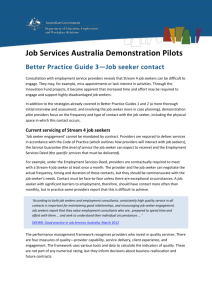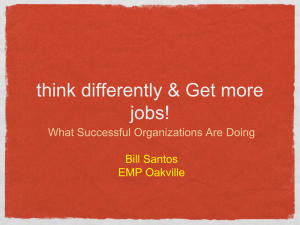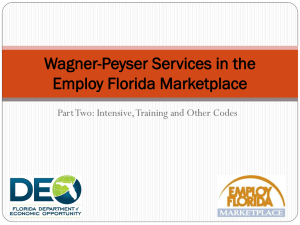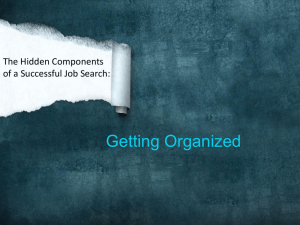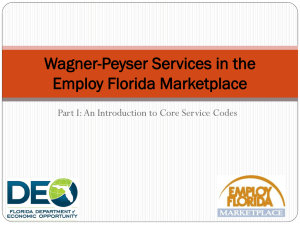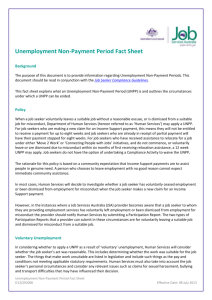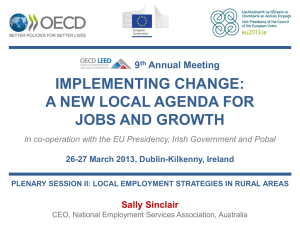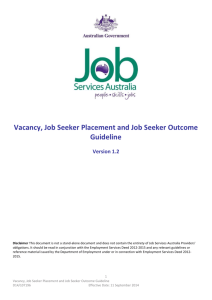DOCX file of Better Practice Guide 1: Assessment
advertisement
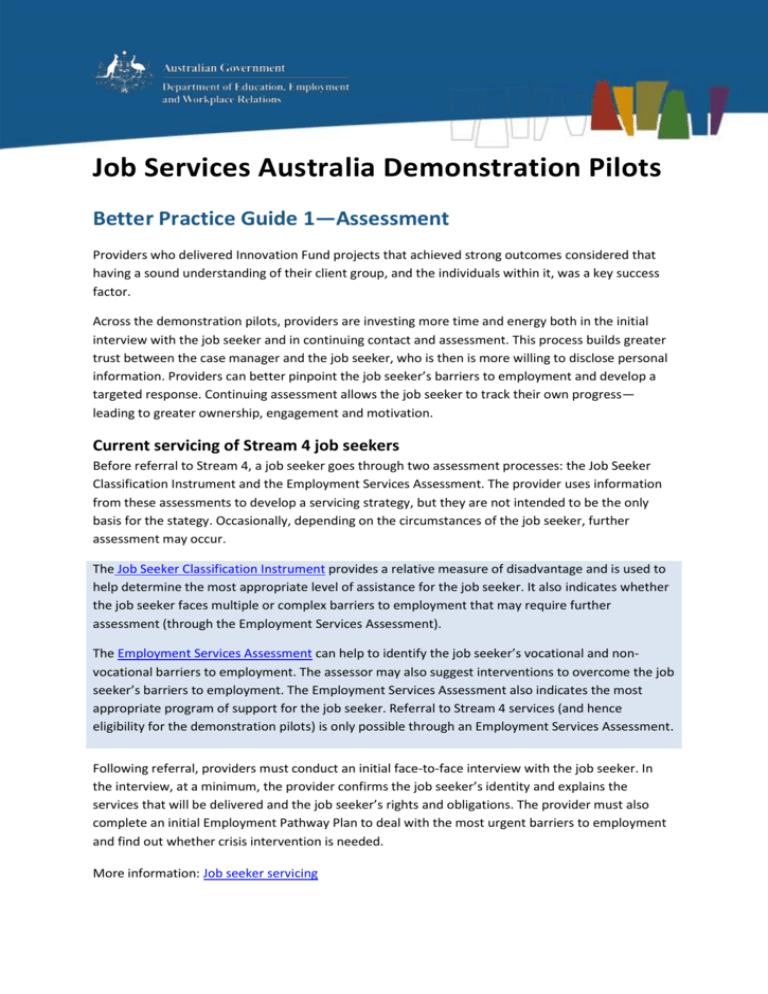
Job Services Australia Demonstration Pilots Better Practice Guide 1—Assessment Providers who delivered Innovation Fund projects that achieved strong outcomes considered that having a sound understanding of their client group, and the individuals within it, was a key success factor. Across the demonstration pilots, providers are investing more time and energy both in the initial interview with the job seeker and in continuing contact and assessment. This process builds greater trust between the case manager and the job seeker, who is then is more willing to disclose personal information. Providers can better pinpoint the job seeker’s barriers to employment and develop a targeted response. Continuing assessment allows the job seeker to track their own progress— leading to greater ownership, engagement and motivation. Current servicing of Stream 4 job seekers Before referral to Stream 4, a job seeker goes through two assessment processes: the Job Seeker Classification Instrument and the Employment Services Assessment. The provider uses information from these assessments to develop a servicing strategy, but they are not intended to be the only basis for the stategy. Occasionally, depending on the circumstances of the job seeker, further assessment may occur. The Job Seeker Classification Instrument provides a relative measure of disadvantage and is used to help determine the most appropriate level of assistance for the job seeker. It also indicates whether the job seeker faces multiple or complex barriers to employment that may require further assessment (through the Employment Services Assessment). The Employment Services Assessment can help to identify the job seeker’s vocational and nonvocational barriers to employment. The assessor may also suggest interventions to overcome the job seeker’s barriers to employment. The Employment Services Assessment also indicates the most appropriate program of support for the job seeker. Referral to Stream 4 services (and hence eligibility for the demonstration pilots) is only possible through an Employment Services Assessment. Following referral, providers must conduct an initial face-to-face interview with the job seeker. In the interview, at a minimum, the provider confirms the job seeker’s identity and explains the services that will be delivered and the job seeker’s rights and obligations. The provider must also complete an initial Employment Pathway Plan to deal with the most urgent barriers to employment and find out whether crisis intervention is needed. More information: Job seeker servicing A detailed Employment Pathway Plan may not be possible at this point because the provider needs to build trust and rapport with the job seeker. The provider is expected to conduct a Skills Assessment during the period of service to inform the Employment Pathway Plan. The Skills Assessment generally covers the job seeker’s existing skill set, aptitude and qualifications for various types of work, their future needs (linked to the local labour market), and training and other interventions that could help. Again, the assessment can be completed after the provider has built a relationship with the job seeker. Under current arrangements, further assessment of the job seeker can occur when the provider or Department of Human Services is aware that the job seeker’s circumstances have significantly changed, or when the job seeker reveals new or additional information that affects their servicing arrangements. What are the demonstration pilots trialling? In the demonstration pilots providers are trialling enhanced initial assessment and formal, structured ongoing assessment. Providers report that a thorough initial assessment, which uses the results of (but is not reliant on) the Job Seeker Classification Instrument and the Employment Services Assessment, is crucial in developing the Employment Pathway Plan. Features may include: expanding the content of the assessment beyond vocational concerns (for example, considering the job seeker’s social and home life, or including cohort-specific questions to trigger discussion about known risk factors) using standardised instruments and psychological tools that provide a reliable and comprehensive picture of the job seeker’s needs, and that can measure change over time adopting a diagnostic or clinical approach to try to find the underlying causes of issues, rather than responding to symptoms allowing ample time, because some issues or barriers may not be disclosed immediately engaging specialist staff (such as allied health professionals) to undertake, or participate in, the assessment process. Providers also report that reassessment at regular intervals can identify new barriers as they emerge (leading to adjustments in the servicing approach) and allows tracking of a job seeker’s progress to employment.1 In most of the pilots, job seekers can track their own progress against pre-determined goals. This helps them to take ownership of their situation and motivates them. See also Better Practice Guide 8—Social outcomes Pilot providers that are delivering a structured program of support (such as a time-limited course or scheduled activities) generally conduct reassessments at pre-determined stages (commencement, mid-point and end of program). Providers of less structured programs conduct reassessments every two or three months, or continuously, or as required. 1 The trial of approaches to measuring social outcomes is an objective of the demonstration pilots; therefore nearly all pilot providers are reassessing progress against a baseline primarily for this purpose. The pilot provider may include the same staff member in all assessments, demonstrating to the job seeker that this person has a personal interest and is committed to the process, and also allowing consistent evaluation. Assessment tools At the initial assessment providers use various assessment tools, either custom-designed or off-theshelf. Some examples follow. Personal and health assessment (CVGT Australia—Connect 4) CVGT conducts a personal assessment to help the job seeker become an active player in their own servicing strategy. The assessment identifies potential team members, personal barriers, vocational barriers and more. An external organisation conducts a formal health assessment. The job seeker and the case management team discuss the results of both assessments. ‘The Health Assessments have worked well—in some cases the health assessments have identified a far greater need for additional intervention than was anticipated. It has increased overall participant wellbeing, and improved timeliness of engagement with health professional …’ CVGT Australia—Connect 4 Work-readiness assessment tool (BoysTown—Stream 4 Outcomes) BoysTown developed the work-readiness assessment tool in partnership with Net Balance. Questions are grouped into 14 employability dimensions (including job search skills, relationships, money, accommodation, physical health, and drug and alcohol use). Job seekers are rated against each dimension on a scale of 1 to 10, with 10 being ‘self-reliance’. ‘The work-readiness tool has received positive feedback from the dual case management team and pilot participants. The assessment results show the types of issues that clients have and then guide … the decisions about the type of activities offered. The participants appear to be responsive because they feel there is recognition that their non-vocational issues are being acknowledged and addressed along with their vocational barriers.’ BoysTown—Stream 4 Outcomes DiSC® profiling (Jobs Statewide—Skills for a Purpose) Jobs Statewide is using DiSC® profiling (dominance, influence, steadiness, conscientiousness) to assess the job seeker’s current situation, their needs, and their interactions with those around them. A report explains the overall style of an individual participant and examines how they are likely to perform in a job. The DiSC® profile matches participants to jobs by comparing the job seeker’s main personality features against any number of specified job requirements. More information: www.discprofile.com ‘We have found [DiSC®] to be an excellent tool for describing a person’s general behaviour and predicting their likely reaction in a range of circumstances.’ Jobs Statewide—Skills for a Purpose Needs assessment and psychometric testing (MAX Employment—multiple pilots) All participants complete an initial needs assessment with a health officer to set and review goals for their lifestyle, vocation and health. They also undertake psychometric testing that measures life satisfaction; general self-efficacy; social connectedness; depression, anxiety and stress; and, as relevant, alcohol and drug dependence. Literacy and numeracy, reasoning and temperament testing (ORS Employment—Youth pilot) A psychologist conducts a vocational assessment to help determine a suitable vocation. This includes assessing the job seeker’s literacy and numeracy skills, their abstract reasoning skills and their temperament. If the assessment identifies problems with literacy or numeracy, the client is referred to the Language, Literacy and Numeracy Program (LLNP). Clients can participate in both programs at the same time and ORS Employment works with the LLNP provider to ensure that the client’s needs are met. Biopsychosocial assessment and DASS 21 (Service to Youth Council—Launch pilot) Service to Youth Council uses two comprehensive clinical assessments that the Clinical Case Manager completes with the job seeker. The biopsychosocial assessment has a broad focus: mental and physical health, housing, alcohol and other drug use, criminal history, family and peer relationships, community engagement, work and volunteer history. The DASS 21 (Depression and Anxiety Scale–short form) is a qualitative survey tool that assesses levels of depression, anxiety and stress in terms of hopelessness, devaluation of life, selfdeprecation, lack of interest or involvement, and anxiety. More information: www2.psy.unsw.edu.au/dass Early learnings Preliminary conclusions from the pilots are that a thorough personal assessment can provide job seekers with greater clarity about their personal situation and barriers to employment, and can strengthen their engagement. Job seekers become accustomed to the routine, and are regularly reminded of their goals and their progress toward them. In many of the pilots, providers report that job seekers have taken more responsibility for changing damaging attitudes and dealing with issues. ‘Based on feedback from the Stream 4 Consultant, Mental Health Coordinator and pilot participants, the additional time devoted to identifying and addressing the participants’ nonvocational and health barriers has enhanced their motivation to maintain engagement with the project and work towards achieving their goals.’ PVSWorkfind—Beacon project Across the pilot, providers report that job seekers are well satisfied with the quality of the assessments. Rather than seeing the extended assessment processes as an imposition, job seekers respond positively and feel that they are understood. ‘I understand myself better now. Before speaking to [the case manager] I thought I was weird or crazy but [we] got an assessment done and now I get why I am the way I am. Now I have time to think about getting a job rather than the other stuff—I’m a lot more happy about my life.’ Job seeker Assessment processes that cover broad life issues may encourage job seekers to disclose information about their barriers and personal circumstances, allowing a faster and more appropriate response, including referral to specialist services if needed. Interim reports also suggest that ongoing assessment can have long-term benefits. Time invested at the beginning, and regularly thereafter, makes the assessment more accurate and allows rapid referral to specialist services and tailoring of specific interventions to meet the job seeker’s needs. Reports from pilot providers suggest that, as trust and rapport increase and the job seeker feels more comfortable disclosing information, the benefits of formal reassessment may diminish. The job seeker may begin to disclose barriers without formal assessment. As noted by the MAX Employment pilot (Ipswich), ‘A key learning has been that due to the trust built throughout the program, the participant has felt safe revealing otherwise unspoken barriers and truly seek help. Some barriers were often not revealed until late in the program, often after several weeks.’ Where job seekers are deliberately concealing barriers, they may reveal them only during periods of intensive engagement and frequent contact. ‘The high rate of job seeker engagement in the training and pre-employment courses [is] associated with the courses being designed to meet the job seekers’ needs identified in the initial assessment.’ ORS Employment—HOPE project Of the 78 participants in this pilot at the time of reporting, 63 had undertaken training through the pre-employment courses. See also Better Practice Guide 3—Job seeker contact Implications for 2015 The pilots indicate that a high-quality initial assessment process, building on the results of the Job Seeker Classification Instrument assessment and the Employment Services Assessment, can encourage job seekers to reveal more and enable tailored and timely interventions. Early indications are that ongoing assessment creates routine and structure, allowing the job seeker to track their own progress against their goals. Customised or off-the-shelf assessment tools can support this process, and also rigorously track progress against a baseline. Although initial and ongoing assessment requires more time and investment, early evidence suggests that it leads to long-term gains. These Better Practice Guides reflect the processes and strategies providers have used to deliver services under the Job Service Australia Demonstration Pilots. They are not intended to offer evidence about the performance of the pilots. The guides disaggregate pilot services into distinct service elements to aid in presentation and reference only. Interactions occur between all aspects of services and all areas should be considered when looking at the provision of good practice services to highly disadvantaged job seekers.


